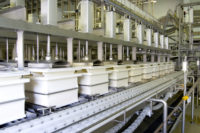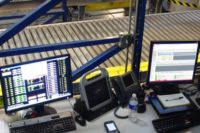
by Lynn Petrak
RFID emerges as the new frontier as processors shop for
logistics systems.
It’s one thing to
process and package dairy products, which is almost always done under one
roof. It’s quite another to move those products from Point A to Point
B, and perhaps on to Points C and D, with limited in-house control over
logistics and distribution.
During the time products are stored, taken to the
loading dock and delivered to their destination, there any many points
along the way where things could go wrong, resulting in decreased employee
productivity, inventory loss, spoiled products and dissatisfied customers
with incorrect orders.
To ensure systems run as smoothly as possible, dairy
processors can choose from an array of software programs and services that
automate, regulate and verify inventory control and order fulfillment,
among other functions.
As the dairy industry has evolved, the need for
higher-tech management of logistics and distribution has become apparent.
Thanks to ever-improving software and hardware capabilities, such systems
are readily available.
Many software suppliers cite the dairy industry as a
dynamic one with great potential. “Forty years ago, a guy filled the
truck and went to the store and delivered it. Dairies have moved from a
milkman business to a delivery execution business and, certainly,
technology has been critical in that evolution,” says Robert
Hochberg, chief executive officer of Numeric Computer Systems Inc. (NCS),
Hauppauge, N.Y.
Patrick Pilz, president of San Diego-based CSB-System
International, agrees there is an untapped market for innovative software
systems in the dairy supply chain. “In dairy, you find a lot of
home-grown systems that have old technology that are going to be
replaced,” he says. “Dairy right now in our segment is the
second most active market — it’s more active than bakery,
processed food and fruits and vegetables.”
The movement — however rapid or slow —
toward upgrading software systems represents a major change in how things
are done on the warehousing and distribution side of the business.
“Many of these legacy systems are paper based,” says Pilz.
“But that’s now going to change, as processors look at the
overall picture and overall solution.”
Hochberg, too, believes that various factors are
falling into place allowing dairies to improve their software-based
capabilities. “Everyone is realizing they have to work on their
back-end distribution system. They may have upgraded their manufacturing
system, and now we are beginning to see people understanding that they have
to deliver Web solutions to connect to their clients in the fulfillment
process,” he explains. “With the consolidation of suppliers and
retailers, the push is to drive cost out of the systems, meaning fewer
people need to be involved. How do you do that? You do it with
technology.”
Track and Field
Software systems are designed to perform a host of
functions, but one of their central applications for the proverbial back
end of the dairy business is product logging and tracking.
That capability is needed more in today’s
production climate than ever before, says Pilz. “The number of SKUs
that they (dairies) have to organize on the truck is much larger. The
organization of the truck and the loading needs to be more reliable,”
he says.
Hochberg agrees. “It all happens so fast, the
pace of it. If you’ve been on the back of a truck, it’s such a
hectic place, especially as bigger deliveries are being done and customer
satisfaction and service are so important,” he says.
Different software companies specialize in particular
software systems, including several aimed at improving logging and
tracking, beginning in the warehouse and loading dock of a plant.
Ontario-based Radcliffe Systems Inc., for example, produces supply chain
browser-based logistics software and consulting services for many dairy
manufacturers who are often overwhelmed by pressure to reduce supply chain
costs while providing higher service levels.
According to company president Fred Radcliffe, the
firm’s extensive experience with dairy clients has helped it develop
software that takes into account the industry’s needs.
“We’ve done work over the years with fluid dairy, cheese,
yogurt, spreads, butter and ice cream. Because of that, we have a warehouse
management system that we’ve actually enhanced to address a number of
their functional requirements,” he explains. “In dairy,
especially in fluid dairy, how they pick cases onto a conveyor line takes
some unusual functionality to manage. Also, you have a lot of
cross-docking, moving products from production directly to a
trailer.”
Beyond warehouse management, transportation management
is a key issue in software used for supply chain management. Among other
functions, software from CSB-System helps dairy processors in logging and tracking on the road.
“On trucks, they can use route accounting software so people can
track the time of delivery. The drivers can work all day, come back to the
plant and, within a radius of 100 feet, they can synchronize their sales on
a computer and upload all the information they got on that route,”
says Pilz.
Hand-held scanners on the route, he says, allow
drivers to get real-time information that works with the company’s
various software programs. “You see what was loaded on the truck and
can account for what was loaded on the truck versus what was sold,”
says Pilz.
Currently, CSB-System offers a series of software
solutions for applications ranging from warehouse to transportation
management, including the Navision edition of Microsoft Business Solutions,
a fully integrated business software package for medium-sized organization
that includes supply chain collaboration and customer relationship
management (CRM). The company also supplies SYSPRO software and Microsoft
CRM, specifically for CRM applications.
In addition to gathering and tracking data,
CSB’s systems also help improve efficiency, says Pilz. “Say you
have any agreement with a customer that he needs to place an order by 8
a.m. If he doesn’t call by 8:01, a message will come up that the
customer hasn’t placed it, so someone can call them back. It makes
sure as soon as something out-of-schedule happens that they get
automatically notified and can act accordingly,” he says.
NCS, meanwhile, specializes on the execution side of
supply chain management, working with companies that employ a direct store
delivery (DSD) sales team to sell, deliver and service products. The
company helps integrate a customer’s back office system to its
Internet-enabled route accounting application; NCS’s software suite
of mobile applications then takes the data through the delivery point.
NCS’s software works on wireless systems and Web
services that enable a dairy driver or delivery person to reliably and
consistently synchronize and exchange information. “We basically
automate the last mile (of the supply chain), from the warehouse to shelf.
It’s connectivity in a real sense that you can actually get data from
the air — you can walk in a store and find out where the stock room
is, what the inventory is,” Hochberg says. “It’s about
having their machine talk to yours and tell you that they have 500 gallons
on the shelf and to bring in X number of gallons to the back.”
Tied into transportation and delivery logistics, of
course, is productivity. On the warehouse side of the business, Radcliffe
recently purchased a company that specializes in labor standards software.
“Basically, you send an industrial engineer in a warehouse for six
weeks and he or she creates labor standards for each location in the
warehouse. Later, when you are order picking, the software can calculate
how much time it should take to pick that order and you track the
employee’s actual time against the target time,” Radcliffe
says. “The productivity goes up when people know they are being
tracked objectively, and they work faster.”
Software is available for transportation productivity
issue as well. CSB-System has worked with companies that have invested in
sophisticated setups on their trucks and trailers. “Most modern
trucks now allow the capture from the engine certain information from the
computer — it can capture the time when the truck was running and
going. If someone makes an unexpected stop and the engine is shut down for
more than 10 minutes, they’ll know,” Pilz says. “That
gets much tighter control for drivers.”
Emerging Capabilities
While the dairy industry and its retail counterpart
have undergone major transformations in the last decade, the pace of
technological improvements during that same period has been nothing short
of remarkable. “The dairy industry hasn’t changed as much as
the computer industry has changed,” says Hochberg.
To that end, the growth of wireless technology is
helping make software that much more efficient and reliable. “Our
solutions deliver instant infrastructure. The whole idea of having
solutions based on the technology of the Internet will give consistent
product and user interfaces,” says Hochberg.
Pilz, too, cites the expansion of general Internet and
communications technology as key to software improvements. “You can
use standard wireless technology in hand-helds (scanners) that have a huge
capacity — they can have up to 250 megabytes now. You are talking
networking speed, and there is no limitation in terms of what you can
do,” he says.
In addition to wireless technology, Radcliffe believes
activated voice technology is another important development with
implications for dairy logistics management and distribution. A few months
ago, Radcliffe developed a reseller relationship with a company that
manufactures voice equipment, and is now working on a pilot program.
“You have a headset on a person in the warehouse and the voice tells
them what location to go to and how many to pick. It’s hands free
— you get a productivity gain with very high accuracy,” says
Radcliffe.
Much of the current buzz in logistics and distribution
is centered on the use of radio frequency identification, or RFID. That
technology, increasingly viewed as a solution over bar-code scanning,
utilizes electromagnetic or electrostatic coupling in the radio frequency
portion of the electromagnetic spectrum to uniquely identify an item and
enable users to store and retrieve data. RFID tags are affixed to a product
or pallet and then read and monitored.
Although discount store giant Wal-Mart is already
using RFID technology and requiring it of its suppliers, software experts
seem to agree that it will affect the dairy industry later rather than
sooner. “When RFID first got talked about, it was assumed that
eventually we would have the ’penny tag,’ which is far from
where we are and even if reached could still be too much money to tag a
consumable item,” says Hochberg. “So it moved from being a
product-level solution to a container-level solution.”
At NCS, Hochberg says the question is, where do we
start with RFID? “The answer we came up with is the load confirmation
process,” he says. “If we light up a loading dock door and each
pallet or case, for example, we can have a monitor show exactly what is on
that truck and what is expected to be on that truck and the variance of
real time. That is the vision we are executing right now.”
Pilz agrees the price has kept the technology
prohibitive, at least for now. “It is a significant expense to do
that. While the cost of the chips is low, the cost of the equipment is
high,” he says.
In addition to the expense of RFID, the technology has
other hurdles for dairy manufacturers. “RF technology gets absorbed
by liquids and therefore cannot be read through or even near
liquids,” says Hochberg.
Enterprising RFID tag and software suppliers are
already trying to figure out ways to update the technology to work with
liquid products. Radcliffe, for his part, says it’s only a matter of
time before the technology is adapted in a broad way. “I don’t
think it will hit dairy for at least five years, but once it does, it will
require new software or equipment,” he says.
Temperature Control
One company is already using RFID technology for dairy
products for at least one function. Montreal-based Syscan International has
developed an RFID-based tracking system called Tempasure™ that
provides a permanent record of a product’s temperature history during
and after shipment.
Currently targeted to meat and poultry processors for
food safety-related traceability purposes, the Tempasure system also has
applications for perishable dairy products. “We are using RFID
temperature records, which enable members of the cold chain to get real
live data at any stage in the game. We monitor real-time, real-temperature
stamps and communicate that in real time, all the time,” says Syscan
president Axel Striefler. “Should anything go wrong, there will be an
immediate message that will be broadcast to respective members in the
chain.”
Other temperature control systems linked to software logistics
programs are available for dairy processors as well. For example, the Stamford,
Conn.-based Dresser Instrument Division of global firm Ebro has linked Winlog
2000 software, compliant to 15 languages, to its series of hand-held EBI series
transportation loggers. “A lot of customers were asking to identify the temperature
of transportation items to be able to monitor whether or not the products went
out of specs during transport, storage or warehousing,” says Benjamin D’Acounto,
North American sales and marketing manager at Dresser. “With these loggers,
you can pre-program them to monitor temperature ranges and set an alarm for
certain conditions.”
Lynn Petrak is a freelance journalist based in the Chicago
area.
$OMN_arttitle="Software Solutions";?>

